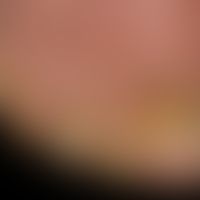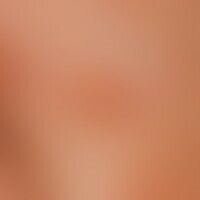Image diagnoses for "yellow"
199 results with 561 images
Results foryellow

Scleromyxoedema L98.5
Scleromyxoedema. 52-year-old male patient. Increasing, moderately itchy skin lesions for 5 years. Thigh with multiple, site scattered lichenoid papules.

Nevus verrucosus Q82.5
naevus verrucosus. already present at birth, bizarrely swirled, linear and flat, yellow-brown, verrucous PLaques. at birth the changes were only schematically indicated. increasingly prominent in the last two years. no subjective symptomatology.

Psoriasis palmaris et plantaris (plaque type) L40.3
Psoriasis palmaris et plantaris (plaquet type): flat (rather discreet) reddening of the palm. circumscribed keratotic plaques and individual erosions and rhagades. no blisters or blisters.

Contagious mollusc B08.1
Molluscum contagiosum: disseminated mollusca contagiosa; first appearance a few weeks after children swim in a heated pool.

Arterial leg ulcer L98.4
Ulcus cruris arteriosum: Detail enlargement: Chronic, slowly progressive, painful, deep ulcer located in the area of the left lateral malleolus in a 70-year-old man.

Herpes simplex virus infections B00.1
Herpes simplex virus infection: Extensive herpes simplex infection of the lower lip with pronounced collateral swelling

Hand dermatitis chronic L30.9
Chronic hand dermatitis: extensive chronic dermatitis of the Palmae region with moderate lichenification.

Cheilitis glandularis purulenta superficialis K13.0
Cheilitis glandularis purulenta superficialis: severe, acutely occurring purulent cheilitis. no evidence of a herpes simplex infection. therapy with systemic cephalosporins. healing after 10 days.

Onychogrypose L60.2
Onychogrypose: extreme, claw-like rolled up growth of the toenails, extreme neglect of nail hygiene.

Sebaceous hyperplasia senile D23.L

Epidermal cyst L72.0

Darian sign
Urticaria pigmentosa of childhood: extensive redness and urticarial reaction in the lesions after mechanical irritation.

Pyoderma L08.00
Pyoderma: multiple fresh and older follicular pustules (purulent folliculitis) with evidence of Staphylococcus aureus; at the right lower border of the picture transition to a deep folliculitis (boils)

Carcinoma verrucous (overview) C44.L
Carcinoma, verrucous. Chronically stationary, slightly increasing in the last 10 years, coarse plaque with dry, dirty yellow or brownish, torn, rough, crusty fissured, verrucous surface.

Penile carcinoma C60.-
Penis carcinoma: plate-like , rough infiltration of the glans penis with extensive fibrin-covered ulceration of the surface, lymphedema of the prepuce in paraphimosis.

Psoriasis (Übersicht) L40.-
Psoriasis palmaris: chronic inpatient plaque psoriasis of the hands with localized, in places striped, keratotic plaques that have been present for years.

Verruca vulgaris B07
Verrucae vulgares: solitary, flat and stalked papules and plaques, also aggregated to beds, with fissured, hyperkeratotic-verrucous surface; secondary findings include lipodystrophy in HIV infection.

Keratosis palmoplantaris cum degeneratione granulosa Q82.8

Pediculosis (overview) B85.2
Pediculosis (overview): masses of nits on the hair shafts in pediculosis capitis.





